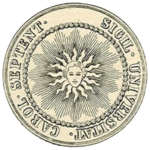University of North Carolina
| University of North Carolina | |
|---|---|
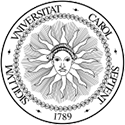 |
|
| Established | 1789 (Chapel Hill) 1972 (statewide system) |
| Type | Public |
| President | Erskine Boyce Bowles |
| Students | 183,000 |
| Location | North Carolina, United States |
| Campus | Multi-Campus University |
| Former names | Consolidated University of North Carolina |
| Website | www.northcarolina.edu |
The University of North Carolina system includes all sixteen public four-year universities in North Carolina, United States and one public residential high school. While the system's Board of Governors oversees general system policy, the campuses are classified as separate institutions and are largely autonomous from the system office. The UNC system has a total enrollment of over 183,000 students and confers over 75% of all bachelor degrees in North Carolina.[1]
Contents |
History
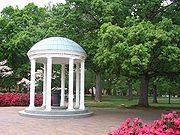
Founded in 1789, the University of North Carolina at Chapel Hill is the oldest public university in the United States. In 1877, the State of North Carolina began sponsoring additional higher education institutions. Over time the state added a women's college, a land-grant university, five historically black institutions, and one to educate Native Americans. Others were created to prepare teachers for public education and to instruct performing artists.
During the Depression, the North Carolina General Assembly searched for cost savings within state government. Towards this effort in 1931, it redefined the University of North Carolina, which at the time referred exclusively to the University of North Carolina at Chapel Hill, using it for the name of the entire University of North Carolina system. The new Consolidated University of North Carolina was created to include the existing campuses of University of North Carolina at Chapel Hill, North Carolina State University, and the University of North Carolina at Greensboro. The three campuses came under the leadership of just one board and one president. By 1969, three additional campuses had joined the Consolidated University through legislative action: the University of North Carolina at Charlotte, the University of North Carolina at Asheville, and the University of North Carolina at Wilmington.
In 1971, North Carolina passed legislation bringing into the University of North Carolina system all 16 public institutions that confer bachelor degrees. This round of consolidation granted each constituent institution a Chancellor and a Board of Trustees. In 1985, the North Carolina School of Science and Mathematics, a residential high school for gifted students, was declared an affiliated school of the university. In 2007, the high school became a full member of the system.
Structure
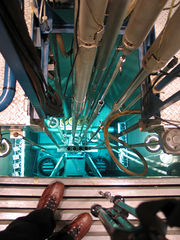
Article IX of the North Carolina State Constitution provides authorization for the creation of the University of North Carolina.[2] Under this authorization, Chapter 116 of the North Carolina General Statutes entrusts the University of North Carolina to its Board of Governors.[3] The Board of Governors is the policy-making body charged with "the general determination, control, supervision, management, and governance of all affairs of the constituent institutions." It elects the president, who administers the university. The 32 voting members of the Board of Governors are elected by the General Assembly for four-year terms. The current Chairwoman of the system's Board of Governors is Hannah Gage, who was preceded by Jim W. Phillips, Jr. The president of the Association of Student Governments is also a non-voting member.
The Board of Governors delegates extensive administrative authority to each constituent university. Each institution is headed by a chancellor, who is chosen by the Board of Governors on the president's nomination and is responsible to the president. Each institution also has a board of trustees, consisting of eight members elected by the Board of Governors, four appointed by the governor, and the president of the student body. The composition of the Board of Trustees is set by statute.
Legal mandate
The legal authority and mandate for the University of North Carolina can be found in the North Carolina Constitution. Article 9 of the constitution deals with all forms of public education in the state. Sections 8 and 9 of that article stipulate the function and cost to students of the University of North Carolina.[3]
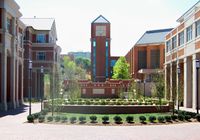
- Sec. 8. Higher education.
The General Assembly shall maintain a public system of higher education, comprising The University of North Carolina and such other institutions of higher education as the General Assembly may deem wise. The General Assembly shall provide for the selection of trustees of The University of North Carolina and of the other institutions of higher education, in whom shall be vested all the privileges, rights, franchises, and endowments heretofore granted to or conferred upon the trustees of these institutions. The General Assembly may enact laws necessary and expedient for the maintenance and management of The University of North Carolina and the other public institutions of higher education.
- Sec. 9. Benefits of public institutions of higher education.
The General Assembly shall provide that the benefits of The University of North Carolina and other public institutions of higher education, as far as practicable, be extended to the people of the State free of expense. [4]
Institutions
Within its seventeen campuses, the system houses two medical schools and one teaching hospital, ten nursing programs, a school of dentistry, and a school of pharmacy, as well as a veterinary school, two law schools, 15 schools of education, three schools of engineering, and a school for performing artists.[1] The oldest university, the University of North Carolina at Chapel Hill, first admitted students in 1795. The smallest and newest member is the North Carolina School of Science and Mathematics, a residential two-year high school, founded in 1980 and a full member of the system from 2007. The largest university is North Carolina State University, with 31,130 students.
While the official names of each campus are determined by the North Carolina General Assembly, abbreviations are determined by the individual school.[5]
| Official name (Previous name) |
Official abbrev. | Location | Enrollment As of 2009 Fall |
Carnegie Classification | Founded | Joined system | References |
|---|---|---|---|---|---|---|---|
| Appalachian State University (Appalachian State Teacher's College, until 1967) |
ASU, App State (for athletics) |
Boone, Watauga County | 16,968 | Master's University | 1899 | 1972 | [6][7] |
| East Carolina University (East Carolina College, until 1967) |
ECU, East Carolina (for athletics) |
Greenville, Pitt County | 27,654 | Doctoral/Research University | 1907 | 1972 | [8][9] |
| Elizabeth City State University (Elizabeth City State College, until 1969) |
ECSU | Elizabeth City, Pasquotank County | 3,264 | Baccalaureate College | 1891 | 1972 | [10][11] |
| Fayetteville State University (Fayetteville State College, until 1969) |
FSU | Fayetteville, Cumberland County | 6,283 | Master's University | 1867 | 1972 | [12][13] |
| North Carolina Agricultural and Technical State University (The Agricultural and Technical College of North Carolina, until 1969) |
NC A&T | Greensboro, Guilford County | 10,614 | Doctoral/Research University | 1891 | 1972 | [14][15] |
| North Carolina Central University (North Carolina College at Durham, until 1969) |
NCCU, NC Central (for athletics) |
Durham, Durham County | 8,587 | Master's University | 1909 | 1972 | [16][17] |
| North Carolina School of Science and Mathematics | NCSSM | Durham, Durham County | 650 | - | 1980 | 2007 | [18] [19] |
| North Carolina State University at Raleigh (North Carolina State College of Agriculture and Engineering, until 1963) |
NCSU, NC State (for athletics) |
Raleigh, Wake County | 33,819 | Doctoral/Research University | 1887 | 1932 | [20][21] |
| University of North Carolina at Asheville (Asheville-Biltmore College until 1969) |
UNCA | Asheville, Buncombe County | 3,897 | Baccalaureate College | 1927 | 1969 | [22][23] |
| University of North Carolina at Chapel Hill (University of North Carolina, until 1963) |
UNC-Chapel Hill,[24] North Carolina (for athletics) |
Chapel Hill, Orange County | 28,916 | Doctoral/Research University | 1789 | 1932 | [25][26] |
| University of North Carolina at Charlotte (Charlotte College, until 1965) |
UNC Charlotte, Charlotte (for athletics) |
Charlotte, Mecklenburg County | 24,701 | Doctoral/Research University | 1946 | 1965 | [27][28] |
| University of North Carolina at Greensboro (North Carolina College for Women, until 1963) |
UNCG | Greensboro, Guilford County | 21,306 | Doctoral/Research University | 1891 | 1932 | [29][30] |
| University of North Carolina at Pembroke (Pembroke State University, until 1996) |
UNCP | Pembroke, Robeson County | 6,661 | Master's University | 1887 | 1972 | [31][32] |
| University of North Carolina at Wilmington (Wilmington College, until 1969) |
UNCW | Wilmington, New Hanover County | 12,924 | Master's University | 1947 | 1969 | [33][34] |
| University of North Carolina School of the Arts (North Carolina School of the Arts, until 2008) |
UNCSA | Winston-Salem, Forsyth County | 872 | Special Focus Institution | 1963 | 1972 | [35][36] |
| Western Carolina University (Western Carolina College, until 1967) |
WCU, Western Carolina (for athletics) |
Cullowhee, Jackson County | 9,429 | Master's University | 1889 | 1972 | [37][38] |
| Winston-Salem State University (Winston-Salem Teacher's College, until 1969) |
WSSU | Winston-Salem, Forsyth County | 6,427 | Baccalaureate College | 1892 | 1972 | [39][40] |
The enrollment numbers are from University of North Carolina System website: http://www.northcarolina.edu/web/facts.php They are the official headcount numbers. It includes all full time and part time, undergrad and postgrad students. It didn't have the North Carolina School of Science and Mathematics enrollment numbers listed, but on its website http://www.ncssm.edu/about-ncssm/facts.php it listed 650 students, and also a side UNC-Greensboro's 2008 numbers on this wikipedia page were incorrect and way off.
With the exception of the University of North Carolina at Pembroke and the University of North Carolina School of the Arts, the institutions that joined the University of North Carolina system in 1972 did so under their current name. As of 2008, all public four-year institutions in North Carolina are members of the system.
Affiliates
| Name | Location | Founded |
|---|---|---|
| North Carolina Arboretum | Asheville, Buncombe County | 1989 |
| North Carolina Center for the Advancement of Teaching | Cullowhee, Jackson County | 1985 |
| North Carolina Center for International Understanding | Raleigh, Wake County | |
| North Carolina Center for Nursing | Raleigh, Wake County | |
| North Carolina State Approving Agency | Raleigh, Wake County | |
| North Carolina State Education Assistance Authority | Raleigh, Wake County | |
| UNC Center for Public Television (UNC-TV) | Research Triangle Park, Durham County | 1955 |
| UNC Faculty Assembly | Chapel Hill, Orange County | |
| University of North Carolina Press | Chapel Hill, Orange County | 1922 |
| UNC Staff Assembly | Chapel Hill, Orange County |
Presidents
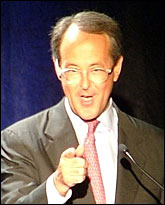
| Name | Term |
|---|---|
| Frank Porter Graham | 1932–1949 |
| William Donald Carmichael, Jr. * | 1949–1950 |
| Gordon Gray | 1950–1955 |
| J. Harris Purks * | 1955–1956 |
| William Clyde Friday * | 1956–1957 |
| William Clyde Friday | 1957–1986 |
| Clemmie Dixon Spangler, Jr. | 1986–1997 |
| Molly Corbett Broad | 1997–2006 |
| Erskine Boyce Bowles | 2006–present[41] |
An asterisk (*) denotes acting president.
See also
- List of colleges and universities in North Carolina
- North Carolina Community College System
References
- ↑ 1.0 1.1 "University Facts". University of North Carolina. 2008-01-10. http://www.northcarolina.edu/content.php/home/facts.htm. Retrieved 2008-03-18.
- ↑ "Article IX - Education". North Carolina State Constitution. North Carolina General Assembly. 2006. http://www.ncga.state.nc.us/enactedlegislation/statutes/html/bychapter/chapter_9.html. Retrieved 2008-03-29.
- ↑ 3.0 3.1 "Chapter 116 - Higher Education". North Carolina General Statutes. North Carolina General Assembly. 2006. http://www.ncga.state.nc.us/enactedlegislation/statutes/html/bychapter/chapter_116.html. Retrieved 2008-03-29.
- ↑ "Article IX". North Carolina Constitution. North Carolina General Assembly. 2006. http://www.ncga.state.nc.us/Legislation/constitution/article9.html. Retrieved 2008-06-09.
- ↑ Wootson, Cleve R., Jr. (2002-01-08). "UNC Leaders Want Abbreviation Change". The Daily Tar Heel. http://media.www.dailytarheel.com/media/storage/paper885/news/2002/01/08/UndefinedSection/Unc-Leaders.Want.Abbreviation.Change-1346331.shtml. Retrieved 2008-06-19.
- ↑ "Appalachian State University". Institutional Profiles. University of North Carolina. 2007. http://intranet.northcarolina.edu/docs/assessment/Profiles/2007-08/ASU_Inst._Profile_07-08_10.pdf. Retrieved 2008-03-18.
- ↑ "Appalachian State University". Carnegie Classifications. The Carnegie Foundation for the Advancement of Teaching. 2007. http://intranet.northcarolina.edu/docs/assessment/Profiles/2007-08/ASU_Inst._Profile_07-08_10.pdf. Retrieved 2008-03-18.
- ↑ "East Carolina University". Institutional Profiles. University of North Carolina. 2007. http://intranet.northcarolina.edu/docs/assessment/Profiles/2007-08/ECU_Inst._Profile_07-08_12.pdf. Retrieved 2008-03-18.
- ↑ "East Carolina University". Carnegie Classifications. The Carnegie Foundation for the Advancement of Teaching. 2007. http://intranet.northcarolina.edu/docs/assessment/Profiles/2007-08/ECU_Inst._Profile_07-08_12.pdf. Retrieved 2008-03-18.
- ↑ "Elizabeth City State University". Institutional Profiles. University of North Carolina. 2007. http://intranet.northcarolina.edu/docs/assessment/Profiles/2007-08/ECSU_Inst._Profile_07-08_14.pdf. Retrieved 2008-03-18.
- ↑ "Elizabeth City State University". Carnegie Classifications. The Carnegie Foundation for the Advancement of Teaching. 2007. http://intranet.northcarolina.edu/docs/assessment/Profiles/2007-08/ECSU_Inst._Profile_07-08_14.pdf. Retrieved 2008-03-18.
- ↑ "Fayetteville State University". Institutional Profiles. University of North Carolina. 2007. http://intranet.northcarolina.edu/docs/assessment/Profiles/2007-08/FSU_Inst._Profile_07-08_16.pdf. Retrieved 2008-03-18.
- ↑ "Fayetteville State University". Carnegie Classifications. The Carnegie Foundation for the Advancement of Teaching. 2007. http://intranet.northcarolina.edu/docs/assessment/Profiles/2007-08/FSU_Inst._Profile_07-08_16.pdf. Retrieved 2008-03-18.
- ↑ "North Carolina Agriculture and Technical State University". Institutional Profiles. University of North Carolina. 2007. http://intranet.northcarolina.edu/docs/assessment/Profiles/2007-08/NCAT_Inst._Profile_07-08_18.pdf. Retrieved 2008-03-18.
- ↑ "North Carolina Agriculture and Technical State University". Carnegie Classifications. The Carnegie Foundation for the Advancement of Teaching. 2007. http://intranet.northcarolina.edu/docs/assessment/Profiles/2007-08/NCAT_Inst._Profile_07-08_18.pdf. Retrieved 2008-03-18.
- ↑ "North Carolina Central University". Institutional Profiles. University of North Carolina. 2007. http://intranet.northcarolina.edu/docs/assessment/Profiles/2007-08/NCCU_Inst._Profile_07-08_20.pdf. Retrieved 2008-03-18.
- ↑ "North Carolina Central University". Carnegie Classifications. The Carnegie Foundation for the Advancement of Teaching. 2007. http://intranet.northcarolina.edu/docs/assessment/Profiles/2007-08/NCCU_Inst._Profile_07-08_20.pdf. Retrieved 2008-03-18.
- ↑ "North Carolina School of Science and Mathematics". http://www.ncssm.edu/. Retrieved 2008-03-29.
- ↑ http://www.ncssm.edu/about-ncssm/facts.php
- ↑ "North Carolina State University". Institutional Profiles. University of North Carolina. 2007. http://intranet.northcarolina.edu/docs/assessment/Profiles/2007-08/NCSU_Inst._Profile_07-08_24.pdf. Retrieved 2008-03-18.
- ↑ "North Carolina State University". Carnegie Classifications. The Carnegie Foundation for the Advancement of Teaching. 2007. http://intranet.northcarolina.edu/docs/assessment/Profiles/2007-08/NCSU_Inst._Profile_07-08_24.pdf. Retrieved 2008-03-18.
- ↑ "University of North Carolina at Asheville". Institutional Profiles. University of North Carolina. 2007. http://intranet.northcarolina.edu/docs/assessment/Profiles/2007-08/UNCA_Inst._Profile_07-08_26.pdf. Retrieved 2008-03-18.
- ↑ "University of North Carolina at Asheville". Carnegie Classifications. The Carnegie Foundation for the Advancement of Teaching. 2007. http://intranet.northcarolina.edu/docs/assessment/Profiles/2007-08/UNCA_Inst._Profile_07-08_26.pdf. Retrieved 2008-03-18.
- ↑ http://media.www.dailytarheel.com/content/image-everything-unc
- ↑ "University of North Carolina at Chapel Hill". Institutional Profiles. University of North Carolina. 2007. http://intranet.northcarolina.edu/docs/assessment/Profiles/2007-08/UNC_CH_Inst._Profile_07-08_28.pdf. Retrieved 2008-03-18.
- ↑ "University of North Carolina at Chapel Hill". Carnegie Classifications. The Carnegie Foundation for the Advancement of Teaching. 2007. http://intranet.northcarolina.edu/docs/assessment/Profiles/2007-08/UNC_CH_Inst._Profile_07-08_28.pdf. Retrieved 2008-03-18.
- ↑ "University of North Carolina at Charlotte". Institutional Profiles. University of North Carolina. 2007. http://intranet.northcarolina.edu/docs/assessment/Profiles/2007-08/UNCC_Inst._Profile_07-08_30.pdf. Retrieved 2008-03-18.
- ↑ "University of North Carolina at Charlotte". Carnegie Classifications. The Carnegie Foundation for the Advancement of Teaching. 2007. http://intranet.northcarolina.edu/docs/assessment/Profiles/2007-08/UNCC_Inst._Profile_07-08_30.pdf. Retrieved 2008-03-18.
- ↑ "University of North Carolina at Greensboro". Institutional Profiles. University of North Carolina. 2007. http://intranet.northcarolina.edu/docs/assessment/Profiles/2007-08/UNCG_Inst._Profile_07-08_32.pdf. Retrieved 2008-03-18.
- ↑ "University of North Carolina at Greensboro". Carnegie Classifications. The Carnegie Foundation for the Advancement of Teaching. 2007. http://intranet.northcarolina.edu/docs/assessment/Profiles/2007-08/UNCG_Inst._Profile_07-08_32.pdf. Retrieved 2008-03-18.
- ↑ "University of North Carolina at Pembroke". Institutional Profiles. University of North Carolina. 2007. http://intranet.northcarolina.edu/docs/assessment/Profiles/2007-08/UNCP_Inst._Profile_07-08_34.pdf. Retrieved 2008-03-18.
- ↑ "University of North Carolina at Pembroke". Carnegie Classifications. The Carnegie Foundation for the Advancement of Teaching. 2007. http://intranet.northcarolina.edu/docs/assessment/Profiles/2007-08/UNCP_Inst._Profile_07-08_34.pdf. Retrieved 2008-03-18.
- ↑ "University of North Carolina at Wilmington". Institutional Profiles. University of North Carolina. 2007. http://intranet.northcarolina.edu/docs/assessment/Profiles/2007-08/UNCW_Inst._Profile_07-08_36.pdf. Retrieved 2008-03-18.
- ↑ "University of North Carolina at Wilmington". Carnegie Classifications. The Carnegie Foundation for the Advancement of Teaching. 2007. http://intranet.northcarolina.edu/docs/assessment/Profiles/2007-08/UNCW_Inst._Profile_07-08_36.pdf. Retrieved 2008-03-18.
- ↑ "North Carolina School of the Arts". Institutional Profiles. University of North Carolina. 2007. http://intranet.northcarolina.edu/docs/assessment/Profiles/2007-08/NCSA_Inst._Profile_07-08_22.pdf. Retrieved 2008-03-18.
- ↑ "North Carolina School of the Arts". Carnegie Classifications. The Carnegie Foundation for the Advancement of Teaching. 2007. http://intranet.northcarolina.edu/docs/assessment/Profiles/2007-08/NCSA_Inst._Profile_07-08_22.pdf. Retrieved 2008-03-18.
- ↑ "Western Carolina University". Institutional Profiles. University of North Carolina. 2007. http://intranet.northcarolina.edu/docs/assessment/Profiles/2007-08/WCU_Inst._Profile_07-08_38.pdf. Retrieved 2008-03-08.
- ↑ "Western Carolina University". Carnegie Classifications. The Carnegie Foundation for the Advancement of Teaching. 2007. http://intranet.northcarolina.edu/docs/assessment/Profiles/2007-08/WCU_Inst._Profile_07-08_38.pdf. Retrieved 2008-03-08.
- ↑ "Winston-Salem State University". Institutional Profiles. University of North Carolina. 2007. http://intranet.northcarolina.edu/docs/assessment/Profiles/2007-08/WSSU_Inst._Profile_07-08_40.pdf. Retrieved 2008-03-18.
- ↑ "Winston-Salem State University". Carnegie Classifications. The Carnegie Foundation for the Advancement of Teaching. 2007. http://intranet.northcarolina.edu/docs/assessment/Profiles/2007-08/WSSU_Inst._Profile_07-08_40.pdf. Retrieved 2008-03-18.
- ↑ "Erskine Bowles will retire as UNC president." Bowles has announced that he will retire at the end of 2010 "or as long as it takes to find a successor."
External links
|
||||||||||||||||
|
||||||||
